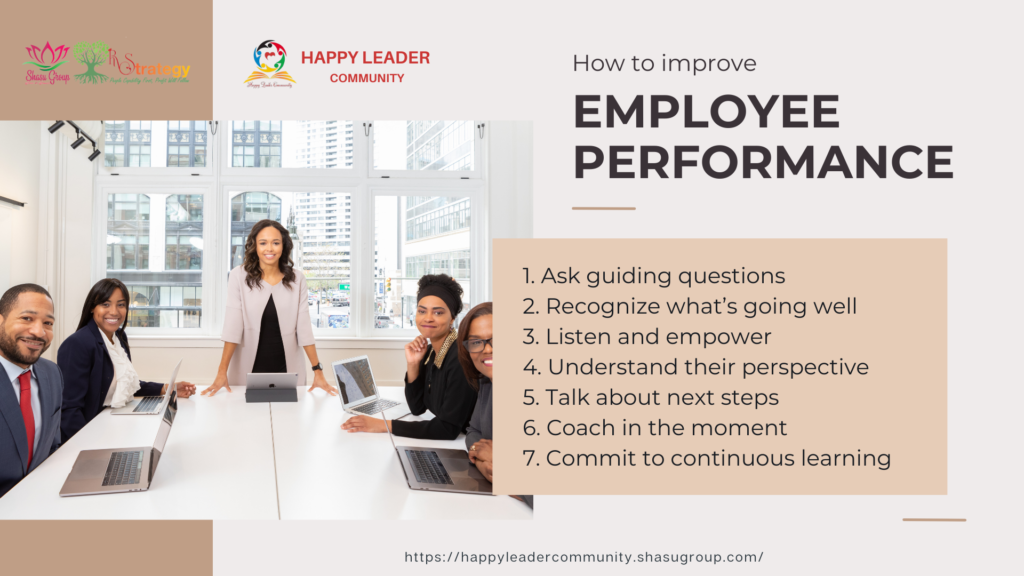Managers and leaders are critical to the success of a business, and so are effective coaching skills. Consistent coaching helps with employee onboarding and retention, performance improvement, skill improvement, and knowledge transfer. On top of these benefits, coaching others is an effective method for reinforcing and transferring learning.
While there are many important leadership skills and competencies, coaching is central to improving the performance of entire teams.
A coaching leadership style is proving to be much more effective with today’s employees than the more authoritarian styles that many business leaders operate under. Leaders who coach employees instead of commanding them are able to build a much more talented and agile workforce, which leads to a healthy and growing business.
How to improve employee performance
Managers and leaders are critical to the success of a business, and so are effective coaching skills. Consistent coaching helps with employee onboarding and retention, performance improvement, skill improvement, and knowledge transfer. On top of these benefits, coaching others is an effective method for reinforcing and transferring learning.

These coaching tips will work with any of those five levels and can help you have more mutually beneficial coaching conversations that will improve overall team performance!
1. Ask guiding questions
Open-ended, guiding questions lead to more detailed and thoughtful answers, which lead to more productive coaching conversations. As a manager or leader, it is critical that you develop strong relationships with your employees. This will help you determine if your employees are curious, have the capacity to perform and improve, and what kind of attitude they have towards their work.
This is where communication skills and emotional intelligence really come into play. Managers must guide conversations both by asking questions and listening, not by giving directives. Employees learn and grow the most when they uncover the answers themselves.
Xem thêm về các nhóm của chúng tôi tại đây
2. Recognize what’s going well
Coaching well requires a balance of criticism and praise. If your coaching conversations are completely focused on what’s not working and what the employee has to do to change, that’s not motivating, it’s demoralizing.
Your recognition of the things your employee is doing well can be a springboard into how they can build from that to improve. We’re not talking about the compliment sandwich here, though, because that coaching technique often devolves into shallow praise that comes off as insincere.
Giving compliments that you don’t actually mean can have a worse effect than not giving any at all, so take the time to think about specific things that are going well, and let your employees know that you see and appreciate them!
3. Listen and empower
Coaching requires both encouragement and empowerment. As a manager and a leader, your job is to build one-on-one relationships with employees that result in improved performance.
Your employees are likely to have a lot of input, questions, and feedback. It’s important for them to know you care enough to listen to what they have to say, so encourage them to share their opinions.
Some employees will have no problem speaking their mind, while others will need a LOT of encouragement before they share an opinion with you openly. Once they do open up, be sure to respect those opinions by discussing them, rather than dismissing them.
4. Understand their perspective
When you’re coaching employees to improve performance and engagement, approaching things from their perspective, rather than your own, will help enormously with seeing the changes and results you want.
Everyone has different motivations, preferences, and personalities, so if you ask questions to help you understand where their “why” comes from and what their preferred “how” looks like, then you can tailor your coaching conversations to align the way they work best with the improvements you’re both aiming for.
With that perspective in mind, you can work with them more effectively on how to get their numbers back up.
5. Talk about next steps
Coaching conversations are meant to yield changes and results, so be sure to clearly define and outline what needs to happen next. This will ensure you and your employee are on the same page with expectations and provide them with a clear understanding of the practical steps they can take to make changes and improve.
Also, these next steps should be mutually agreed upon – talk about what is reasonable to expect given their workload and the complexity of the changes being made.
6. Coach in the moment
If an employee comes to you with a question about a process or protocol, use this opportunity to teach them something new. If you’re not able to stop what you’re doing right away, schedule time with them as soon as possible to go over it.
Better yet, keep a weekly one-on-one meeting scheduled with each employee so you can go over questions and issues regularly while maintaining productivity. Coaching employees with the goal of improving performance means making them a priority each week!
7. Commit to continuous learning
Make a commitment to improving your own skills and competencies. If you’re not continuously learning, why should your employees? Lead by example and your team will follow.
Show that you are interested in their success (why wouldn’t you be?). Ask questions about where they see their career going, or how they see their role evolving in the company. Even if they don’t have a plan laid out yet, these questions will make them think about their career and what they want to accomplish within the organization.
Show your employees that you don’t just want them to do better so you look better, but that you’re actively interested in their career, accomplishments, and professional success.
“If you want your business to thrive, employee morale must be high. If morale is up, so are productivity, profitability, employee pride, and willingness to serve. These happier employees get less sick leave, keep their jobs longer, and they don’t spend time gossiping about what’s wrong with the company, its products, services, and systems. They feel good about the work they do and are proud to contribute and see the business is doing well.” That’s what Terri Lavine has conveyed in her book “Stop Managing, Start Coaching”.
The book provides proven methods to dramatically increase employee morale and retention, including how to generate higher productivity and profitability.
Terri Levine
Terri Levine is known as the business-mentoring expert with heart and is a top business and marketing strategist. She is changing the way business owners around the world connect with their target audiences, then sell and serve their customers and their employees. Terri is known for consulting with business owners to stop selling, marketing, and operating businesses using traditional methods and moves them into true, authentic, heart-to-heart people-centered communication models where sales and marketing are done with authenticity and transparency.
Dr. Levine has more than 30 years of business, sales, and marketing experience encompassing work with over 5,000 business owners. She is also a best-selling author of over 30 titles and a very popular keynote speaker.
Stop Managing, Start Coaching!
Terri Levine coaches businesses of all sizes who want to achieve more success through her methods. Terri is a nationally recognized authority on creating greater business and personal success and regularly appears in a variety of media. She specializes in using Comprehensive Coaching principles to create extraordinary growth for her client’s businesses. She provides workshops, coaching, and keynotes around the world and is passionate about sharing coaching tools to create a new management model.
This book provides proven ways to dramatically increase employee morale and retention, including how to create greater productivity – and profitability! Learn a process that will get great results in a company of any size. This book will teach you: How to lower employee turnover. How to appreciate what employees want and how to reward them. How to use solid tactics to boost morale fast; and. How to take mediocre employees and create high-power performance work teams. Stop Managing, Start Coaching will shift your company culture from managing employees to truly changing employee behavior.
Tham gia cộng đồng học tập suốt đời cùng chúng tôi tại Happy Leader Community
Contents of the book
The book focuses on the biggest business concerns: unmotivated employees and lack of ownership lead to poor service delivery.
- Help business leaders understand how important employee morale is to the success of their business.
- Strongly affirm that coaching skills are the only way for them to effectively continue to develop their team.
- Indicate the essential and important skills of a performance coach
- Demonstrate how managers can balance the roles of coach, mentor, and career coach professionals and interlocutors to improve workplace productivity.
- Show how to develop a realistic and cost-effective human resource strategy. Also, evaluate its impact on performance improvement.
- Reinforce positive traits at work through reward strategies
- Master and practice the art of employee self-esteem – the next step beyond employee empowerment.
Structure of the book
This book is a useful and challenging framework for how to move from management to coaching. Starting with an overview of “Contributions to Managerial Malpractice”, which includes:
- Skills
- Attitude
- Behavior
From there, the author shows how to easily identify:
- What’s Right
- What’s working
- What’s Not Right
Then outline an easy-to-follow process for working toward What’s right. The book explains the concept of “Performance Coaching”, listing the “8 elements of the Performance Coaching Process“:

- Building a new human resource development philosophy
- Modular training
- Creating delivering strategies learning
- Use human resource development professionals as internal consultants responsible for the performance management system
- Strengthen employee relations and create an attitude of ownership
- Use a manager as a coach in training
- Create self-respecting employees and teams
- Identify reward strategies to motivate employees, improve their commitment, and achieve results
Finally, the book outlines 8 coaching principles:
- Connecting
- Listening without reacting
- Reflecting back
- Responding
- Powerful questions, observations, and requests
- Building the employee
- Growing the employee
- Achieving employee goals
Meaning of the book
The book is intended for business leaders and those who are trying to add value to the business. Terri’s advice is to focus on what’s working, rather than what’s not – a fresh and really effective approach to changing what’s happening.
Xem thêm về các nhóm của chúng tôi tại đây
Stop Managing, Start Coaching will shift your company culture from managing employees to actually changing employee behavior. This book will teach you:
- How to reduce employee turnover
- How to express gratitude for employees’ wishes and how to reward them
- How to use solid tactics to boost morale quickly
- How to create high-performing teams from average employees
About my thought
This book embodies the style of Terri with the presentation simple, lucid but powerful, effective and poignant. The book framework is useful, but implementation will still be a challenge. The “how-to” nuts and bolts are left to the reader to learn.
While the authors suggest that coaching shows more genuine concern and respect for people, the book repeatedly defines the outcome of coaching based solely on management terms – for example, increased job performance. “Performance coaching is a series of one-on-one conversations between you and people. The purpose of each exchange is to help you solve problems, improve performance, or achieve results.” This sounds pretty much like traditional command and control management – especially in terms of less “What’s in it for me?” from the employee’s point of view. The author would better demonstrate the value of coaching (compared to management) if he emphasized that coaching balances the benefits of both the trained employee and the business owner.
Collection & Edit by Marketing Dept from Team Happy Leader Community – Shasu Group
Reference:
- https://www.amazon.in/Managing-Start-Coaching-Terri-Levine/dp/0972852727
- https://bitly.com.vn/ljfyx8
- http://profitmagazin.com/editions/number_137.1410.html
- https://www.linkedin.com/pulse/book-review-stop-managing-start-coaching-mike-mai/
- https://www.bizlibrary.com/blog/leadership/7-coaching-tips-managers-leaders/
Follow us:
- Facebook: https://www.facebook.com/HappyLeaderCommunity
- Website: https://happyleadercommunity.shasugroup.com
Our Services
- Business Consultant: https://consultant.shasugroup.com/
- Executive, Business, Performance, Leadership Coaching & Mentoring: https://www.shasugroup.com/coaching-mentoring-consulting
- Training Solution: https://training.shasugroup.com/
- Fundraising & M&A Consultant: http://invest.shasugroup.com/
- International Sales Connection Service: http://export.shasugroup.com/
- Headhunter(Recruitment Service): https://hrstrategyvn.shasugroup.com/









